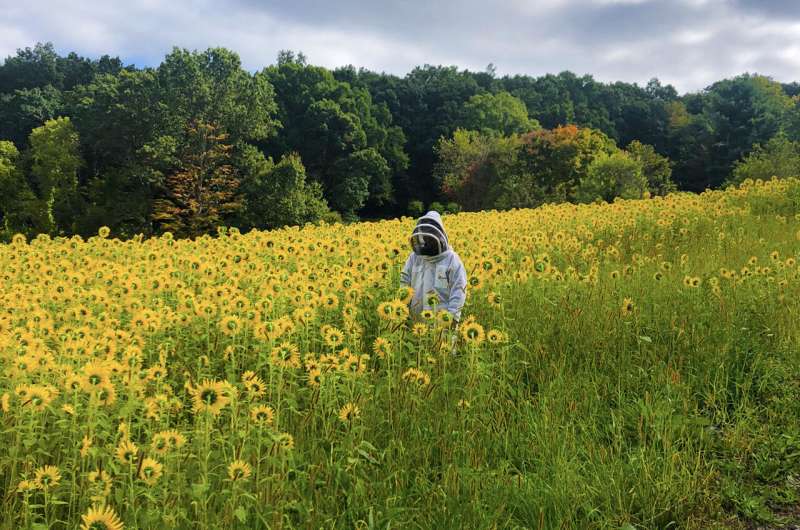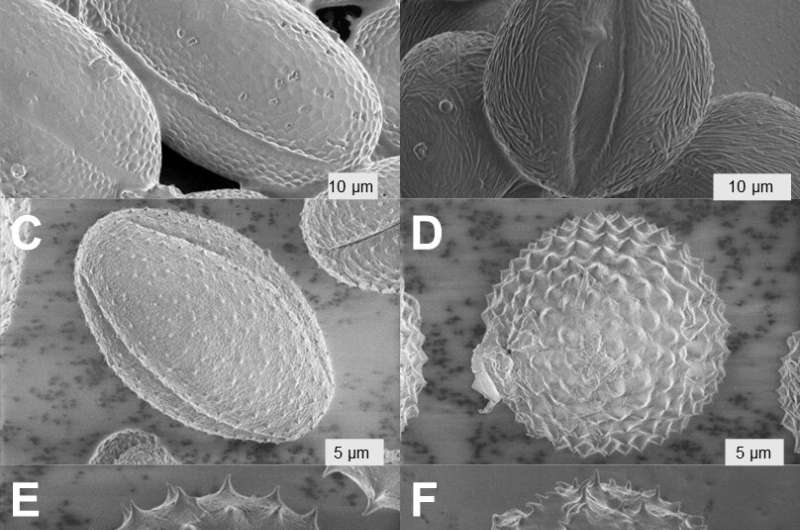This article has been reviewed according to Science X's editorial process and policies. Editors have highlighted the following attributes while ensuring the content's credibility:
fact-checked
peer-reviewed publication
trusted source
proofread
New research finds surprising science behind bumble bee superfood

It's the spines. This is the conclusion of two new papers, led by researchers at the University of Massachusetts Amherst, showing that the spiny pollen from plants in the sunflower family (Asteraceae) both reduces infection of a common bee parasite by 81-94% and markedly increases the production of queen bumble bees.
The research, appearing in Functional Ecology and Proceedings of the Royal Society B: Biological Sciences, provides much-needed food for thought in one of the most vexing problems facing biologists and ecologists: how to reverse the great die-off of the world's pollinators.
Insect pollinators—those flying, buzzing, flitting bugs that help fertilize everything from blueberries to coffee—contribute upwards of $200 billion in annual ecosystem services, worldwide. "We depend on them for diverse, healthy, nutritious diets," says Laura Figueroa, incoming assistant professor of environmental conservation at UMass Amherst and the lead author of the paper on pollen spines. However, many pollinators are suffering an unprecedented decline, due to the widespread use of pesticides, habitat loss and other causes, and scientists around the world are working diligently to figure out how to fight the apocalypse.
One of the big breakthroughs in helping pollinators, and especially bees, is the discovery that certain species of flowers can help pollinators resist disease infections, and that sunflowers are particularly effective at combating a widespread pathogen, Crithidia bombi, that lives in a bee's gut.
But until now, no one knew why sunflowers were so effective at staving off C. bombi, or whether other flowers in the sunflower family had the same pathogen-fighting powers.

Physics, not chemistry
"We know that the health benefits from some foods come from the specific chemicals in them," says Figueroa. "But we also know that some foods are healthy because of their physical structure—think of foods high in fiber."
To discover how sunflowers help bumble bees withstand C. bombi, Figueroa and her team devised an experiment that hinged on separating out the pollen's spiny outer shell from the chemical metabolites in the pollen's core. They then mixed the spiny sunflower shell, with the chemistry removed, into the pollen fed to one batch of bees, while another batch was fed wildflower pollen sprinkled with sunflower metabolites and no sunflower shells.
"We discovered that the bees that ate the spiny sunflower pollen shells had the same response as bees feeding on whole sunflower pollen, and that they suffered 87% lower infections from C. bombi than bees feeding on the sunflower metabolites," says Figueroa.
But that's not all. Bees fed pollen from ragweed, cocklebur, dandelion and dog fennel—all members of the sunflower family and with similarly spiny pollen shells—had low rates of C. bombi infection similar to the bees who ate sunflower pollen—which raises the possibility that such disease-fighting medicinal effects may be common to plants in the sunflower family.
Food fit for a queen
One of the counter-intuitive aspects of the new research is that sunflower pollen is not in itself all that nutritious, because sunflower pollen is low in protein. And while the pollen might be great at protecting bumble bees from a gut pathogen like C. bombi, it would be of little use to feed bumble bees sunflowers and relatives if malnutrition resulted.
"It's no good curing the common cold if you starve the patient," says Lynn Adler, professor of biology at UMass Amherst and the senior author of the paper looking at sunflower pollen and queen bee production. "We need to look at the community level, as well as what's happening in bees' guts, to know how to help them respond to stressful environments," says Adler.
One way to gauge a colony's health is by the number of queens it produces, because queens are the way a bumble bee colony passes on its genes to the next generation. And queens aren't born; they're grown. Colonies use the food resources they've collected to turn a small number of bee larvae into daughter queens. Once the cold weather arrives, all the workers and the old queen will die. The only bees that survive are the new daughter queens. If they survive the winter, they will produce an entirely new colony in the spring. The more queens a colony produces, the higher the likelihood that a colony's genes be passed down through many generations of bees.
To test the impact of sunflowers on colony health, Adler and her team placed commercial colonies of bumble bees on twenty different farms in Western Massachusetts, which grew varying amounts of sunflowers. Over the course of several weeks, the team sampled the pathogens collecting in their bees' guts, weighed the colonies to determine whether or not they were thriving, and counted the number of daughter queens.
"What we found is that infection decreased with increasing sunflower abundance, and perhaps more importantly, queen bee production increased by 30% for every order of magnitude increase in the availability of sunflower pollen," says Rosemary Malfi, lead author of the paper and who completed the research as part of her postdoctoral work in Adler's lab.
Though there's more research to be done into exactly why sunflower pollen benefits queen bees—perhaps bumble bees have more energy for reproduction if they're not fighting disease, or maybe C. bombi impairs learning and foraging, so that reducing infection increases the bees' ability to find food—Adler says that "it's really exciting to show that sunflower not only reduces disease, but positively affects reproduction."
Figueroa and Adler are quick to point out that this research does not represent a solution to the insect apocalypse. This research was conducted using just one common species of bumble bees, which is not endangered. More research needs to be done into how Asteraceae pollen affects other bumblebee species that are threatened. Nor is it known exactly how the spiny Asteraceae pollen protects against C. bombi. But these initial results are encouraging, and indicate that the sunflower family may very well play a role in maintaining pollinator health, and ultimately, the health of our own food systems.
More information: Laura L. Figueroa et al, Sunflower spines and beyond: Mechanisms and breadth of pollen that reduce gut pathogen infection in the common eastern bumble bee, Functional Ecology (2023). DOI: 10.1111/1365-2435.14320
Rosemary L. Malfi et al, Sunflower plantings reduce a common gut pathogen and increase queen production in common eastern bumblebee colonies, Proceedings of the Royal Society B: Biological Sciences (2023). DOI: 10.1098/rspb.2023.0055
Journal information: Proceedings of the Royal Society B , Functional Ecology
Provided by University of Massachusetts Amherst

















